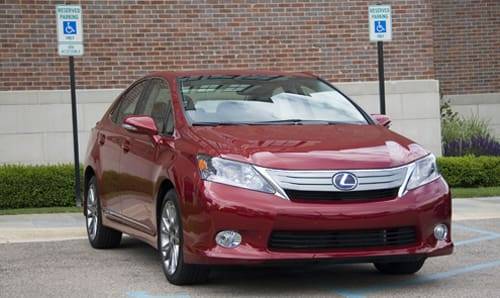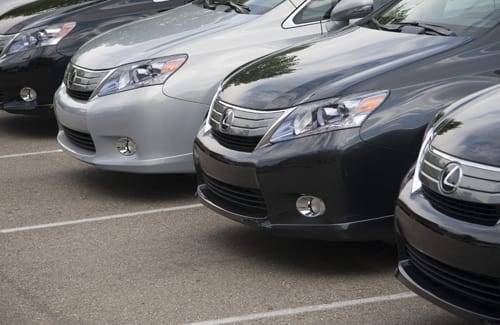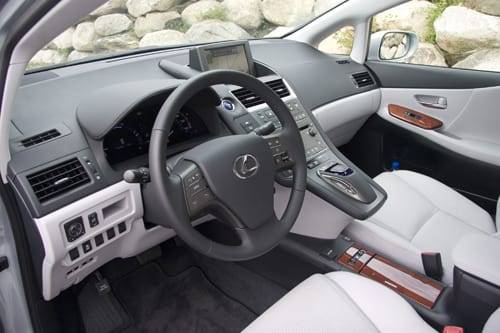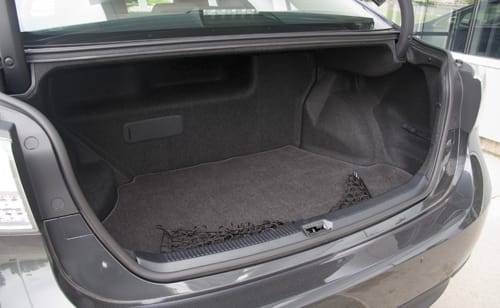2010 Lexus HS 250h: First Drive


The 2010 Lexus HS 250h — the company’s first stand-alone hybrid — won’t hit dealerships until September, but my first drive of some pre-production models left me confident it will be a solid hit.
When you break it down, the two most important facets of any hybrid are its mileage and its price. The HS 250h is EPA rated at 35/34 mpg city/highway, with a combined rating of 35 mpg. Though the price won’t be set until closer to the on-sale date, estimates put it in the mid-$30,000 range. Compared with the 2010 Toyota Prius’ 51 mpg and the midsize Ford Fusion Hybrid’s 41 mpg ratings (both in city driving), 35 mpg doesn’t seem too impressive, but in the world of luxury cars, it’s unbeatable — especially because it calls for regular gas, not premium.

As a class, luxury cars are less efficient than non-luxury cars because they have more standard equipment and more noise-abatement provisions, which add weight. Thanks to the weight and luxury buyers’ insistence on sprightly acceleration, lux models have more engine power and lower efficiency.
By luxury standards, then, the HS 250h isn’t super quick, with a zero-to-60 mph time of more than 8 seconds. It does have that healthy jump off the line that electric motors tend to give you. The continuously variable, shift-free transmission that’s common to Toyota and Ford hybrids lags slightly when you stand on the accelerator for passing power. I seldom have a problem with the way hybrids accelerate, though some people loathe them — along with any car with a continuously variable transmission. If it bothers you, don’t buy it. If it doesn’t bother you, don’t let the haters shame you out of getting one. I suspect the majority of people who get behind the wheel of a hybrid won’t notice much difference, aside from the fact that the engine doesn’t always make noise when you expect it to.
The four acceleration modes — normal, Eco, Power and EV — basically make the accelerator more or less sensitive and the gas engine more or less likely to turn on. For what it’s worth, these modes are about as necessary as they are in any hybrid, which is to say not very. The EV (electric vehicle) mode is particularly annoying: It’s too easy to defeat it and trigger the gas engine — without warning — by accelerating at a rate that’s barely enough to keep from obstructing traffic flow.
The brakes also have the slightly alien feel we’ve come to expect from regenerative brakes, which use the drive motor as a generator to recharge the battery as you come to a stop. It’s perfectly acceptable; my only surprise is that the differences in acceleration and braking have improved gradually over 10 years but haven’t been eliminated.

After considering the fact that Lexus’ other hybrid models all lean toward performance, I think the HS 250h’s combination of modest acceleration and higher mileage is a better approach. The jaw-droppingly expensive LS 600h L goes like a rocket but delivers only 3 mpg more overall than the gas-only LS 460 L (and 1 mpg less on the highway), for a mere $106,035.
The HS 250h’s 2.4-liter four-cylinder and electric motor pairing has been used in the Prius and Camry Hybrid, though this car and the 2010 Prius enjoy the greater efficiencies of the sixth-generation hybrid system. The 2009 Prius used the fourth generation.
The HS 250h also feels sportier than the Prius, though it’s not a lightweight car and you feel its heft when cornering. The center of gravity isn’t as low as I expect from a hybrid, in which the high-voltage batteries tend to sit low. One can’t compare the HS 250h to its non-hybrid version because there isn’t one, but it’s the most efficient luxury car by far and it’s more than respectable overall compared with the smallest econocars. Based on a more obscure platform, its sole relative here in the States is the Scion tC, but that’s a two-door hatchback. The HS 250h is a sedan. Lexus says the HS 250h’s platform was highly modified to make it work optimally as a hybrid — similar to Honda’s claim for the Insight, a re-architected Honda Fit. The HS 250h is larger than the compact Lexus IS sedan but not quite as large as the ES 350 sedan.

The interior is a practical size, with enough headroom and legroom for adults, especially if front occupants are willing to share. Though the pre-production cars’ interiors weren’t all finalized, the important surfaces all look good and feel upscale. One disappointment remains in the HS 250h: It’s yet another hybrid sedan in which the backseat doesn’t fold. Apart from hatchbacks and SUVs, automakers haven’t bridged this gap, because the high-voltage battery invariably goes behind the backseat. The trunk has a large opening and is a decent size at 12.1 cubic feet — about 1 cubic foot shy of the IS sedan and between the Honda Civic Hybrid and Acura TSX. One could argue that cargo versatility isn’t a priority in a luxury car. What is a priority in a luxury car is golf clubs, and Lexus says the HS 250h can hold four sets. A hatchback design would provide more space, but it wouldn’t be good for Lexus’ image.

The HS 250h is a high-tech showcase in the vein of the new Prius. Along with expected options like adaptive cruise control, lane departure warning, heated and cooled front seats and active LED headlights, the HS 250h offers intelligent high beams, which use a color camera to distinguish oncoming headlights from taillights and adjust the brights accordingly. It also has an optional head-up display option that projects speed and a variety of other information on the windshield, and a 180-degree fisheye lens in the grille that practically peers around corners as you edge into an intersection. It displays the image on a navigation screen that emerges from atop the dashboard — as high as possible for safety without blocking the driver’s view.
In addition to the more common MP3 jack and iPod control port, the HS 250h is an early adopter of Bluetooth audio streaming, which lets you play music from a compatible media player through the stereo, without wires. The HS 250h also marks the debut of Lexus Enform, an OnStar-like subscription-based safety and convenience system that can provide traffic, weather, sports and other information. Models without the navigation option are eligible for the safety features alone, called Safety Connect.
Though details are few at this time, another cutting-edge option is one that watches your face as you drive and, if the pre-collision system senses you’re closing too quickly on an obstacle, warns you earlier if you seem to be looking away.
Somewhere along the line, hybrids became desirable for prestige, not just efficiency, and that’s why a luxury hybrid has double the appeal. Though it’s a dedicated model, the HS 250h doesn’t stand out as much as a Prius does, but it has enough subtle badging to be recognized as a hybrid by anyone who bothers to look. More important, it’s a nice-looking sedan, though the grille looks borrowed from Ford. (Lexus emphasizes that the three-bar design has been on concept cars for years; sorry, guys, it’s been on Ford production vehicles for years, too.) Though I preach that the higher efficiency of hybrid technology is welcome in any vehicle type, all the way up to full-size SUVs, the general consensus is that hybrids are supposed to be smaller and boast notably high mpg ratings. Given its size, price and mileage — which hit 38 mpg during my drives with no special effort — the HS 250h will meet an untapped demand.

Former Executive Editor Joe Wiesenfelder, a Cars.com launch veteran, led the car evaluation effort. He owns a 1984 Mercedes 300D and a 2002 Mazda Miata SE.
Featured stories




